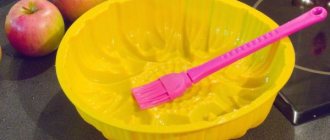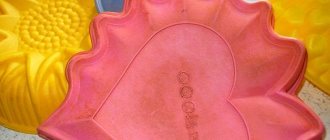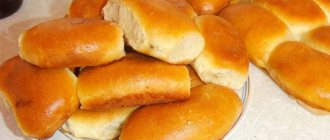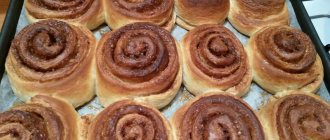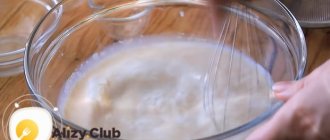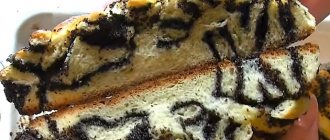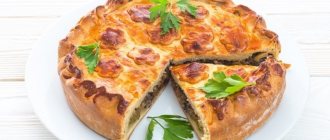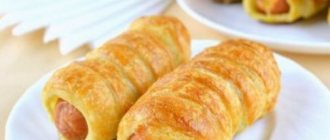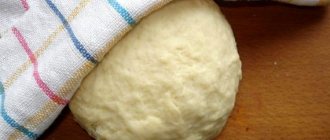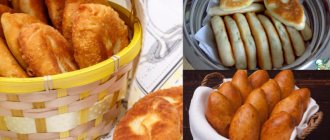Author: Yulia Sabinova. Updated 04/10/2020
When preparing baked goods and baking various products in the oven on a baking sheet, the latter needs an additional coating so that the food does not stick to it and in the future it is easy to clean, so in this review we will look in detail at how and what is the best way to lubricate the baking sheet and how to protect it from burning food.
Types of baking trays
Molds made from different materials require different preparations before baking. In the table I have indicated the most common types of baking sheets and the specifics of their processing.
| Tray material | Does it need to be processed? |
| Aluminum | Be sure to treat all surfaces that the dough touches. Including the lid, if available. Areas where cracks have appeared are especially dangerous for the test. |
| Glass | Heat-resistant glass dishes are greased with oil or covered with parchment paper. |
| Silicone | Immediately after purchase, silicone molds should be thoroughly washed, dried and greased with oil. They are not lubricated during subsequent use. |
| Non-stick | Despite the non-stick coating, the pan must be lubricated with a thin layer of oil. Otherwise, prolonged baking will cause the cake to burn. |
| Paper molds | If the molds are light and feel like wax, there is no need to lubricate them - they are already pre-impregnated with a non-stick compound. Regular molds need to be greased. |
| Split ring molds | The bottom is covered with baking paper, then the ring is closed and the entire surface is coated. This will help you remove the ring from the finished cake without any problems. |
| Ceramic | Ceramic products are characterized by increased porosity. They are not only greased, but also sprinkled with flour on top. |
Whatever the shape, there is no need to fill it with oil. To make the dish work, a thin layer of oil will be enough. The main thing is to allow the coating to spread over the entire surface of the baking sheet, otherwise the dough will still stick in some places.
Why grease a baking tray?
There are three main reasons why housewives grease baking sheets:
- Leave the pie unharmed and protect it from burning.
- Protect the baking sheet from black spots, dough residues, and scratches (which will certainly remain after scraping off the burnt cake).
- Give the bottom of the baked goods a golden brown crust and make them a little juicier if you grease them with something aromatic.
Note! The dough does not always need additional protection. For example, butter in shortcrust pastry is quite enough to ensure that the cake does not burn and remains aromatic. Therefore, it can simply be distributed over a dry form.
Why grease pies?
Homemade baked goods are glazed to give a golden hue and an appetizing appearance. You can grease the pie with various mixtures to obtain a golden brown crust. The choice depends on the dough recipe, the shape and size of the products, as well as your taste preferences.
Before baking
Small pies, puff pastries and cookies cook quickly, which means it is better to grease them before baking. Before placing in the oven, it should be preheated to the appropriate temperature. Then the dough will bake evenly and will not fall off or burn on top.
You need to apply the glazing when the dough has steeped and risen. Gently spread the composition with light movements, trying not to damage the product. To do this, it is better to take a special silicone brush or quill pen. You can fold the gauze several times, dip it in the prepared mixture and squeeze it out a little. Coat the top first, moving from one edge to the other, then coat in a circle. If the buns are coated on all sides, they will brown evenly.
Please note that the temperature of the mixture from which the glaze is made should be above room temperature. Therefore, take the food out of the refrigerator in advance or put it in the microwave for a few seconds.
To give your baked goods an appetizing glow, bake at 200°C and control the process without going far from the kitchen.
After
To make the freshly baked product soft and juicy, glaze it after baking. The hot bun is soaked in heated milk, syrup or honey glaze. An appetizing dish with a rosy hue will please everyone.
During
Some cooks prefer to grease the baked goods during the cooking process. About 10 minutes before the end of baking, remove the product and pour the mixture over it. Then place it back in the oven and continue to monitor the process without moving far from the stove. When the surface is browned, you can take it out.
This glazing option is not suitable for pies made from yeast dough. They cannot be taken out of the oven early, because the dough will fall and lose its airy structure. As a result, your culinary creation may turn out very tough.
How to grease baking trays?
So, how to grease a baking sheet so that the finished dish does not disappoint? Depending on the type of baking, housewives choose one of 3 components.
Vegetable oils
This should be refined sunflower oil. Flavored oil has two disadvantages: it burns hotter and gives the finished cake the taste of old sunflower seeds. Sesame and flaxseed oils make baked goods more flavorful, but if expired they can have a bitter aftertaste. Therefore, it is important to monitor the expiration date.
Animal fats
The ideal option is slightly melted butter. It gives baked goods a creamy aroma and helps form a beautiful golden brown crust. The pie turns out to be very high in calories, but tasty. You can replace butter with margarine or spread, but at high temperatures they burn hotter.
Beeswax
Such a product is rarely found in the kitchen, but this does not reduce its effectiveness. If you melt a small piece of beeswax and spread it over the pan, it will reliably protect the baked goods from burning. But this option is only suitable for sweet pies and buns, since the wax will add a barely noticeable honey smell to the baked goods.
How to grease a baking dish
The baking tray and baking pans must also be greased before starting cooking so that the dough does not stick to them and does not burn during the cooking process.
For these purposes, it is best to use regular sunflower oil (use a silicone brush to grease all the molds or baking sheets), after which they are lightly sprinkled with flour (the flour acts as a kind of barrier between the oil and the baked goods themselves).
Answers to popular questions on the topic: how to grease baked goods so that they shine and have a beautiful golden brown crust
- How to grease puff pastry baked goods? Baked goods made from puff pastry are often brushed with beaten egg yolk (you can also beat the yolk with milk in a one-to-one ratio).
- How to grease the cake after cooking in the oven? Depends on whether the pie is being baked, sweet or savory (for both options, the types of baking lubricants used in cooking are listed above).
- When is it better to brush pies with egg - before or after baking in the oven? The pies are brushed with egg using a silicone brush 7-10 minutes before the end of the baking process (the pies will almost have time to cook and a crust will begin to form on them).
- How to grease buns if you don’t have eggs at home? Instead of eggs, you can use sour cream, sweet black tea, sweet water or vegetable oil (all options are listed in this review).
- When is the best time to brush baked goods at the end of cooking? Buns and pies can be greased 7-10 minutes before the end of baking in the oven, so that a delicate golden brown crust has time to form on their surface.
- What can replace a brush for brushing baked goods? Previously, instead of a silicone brush, feathers were used to lubricate baked goods (for example, one or more goose feathers tied together with a thread); you can also use a piece of clean gauze for these purposes.
- Do aluminum baking pans need to be greased? Like reusable baking pans, aluminum ones are also recommended to be greased.
- What is the best oil to grease a baking pan? Regular vegetable (sunflower) oil, lightly crushed with flour, copes with this task perfectly.
In conclusion to this review, we can conclude that there are quite a lot of options with which you can lubricate baked goods before and after baking from a wide variety of doughs, in order to ultimately get a golden brown crust with a shiny glossy surface. We leave our useful tips and reviews on how to grease pies, buns and pies when baking, as well as molds and baking sheets, in the comments to this
https://infoeda.com/chem-smazyvat-vypechku-pirozhki-bulochki-pirogi.html
What tools are best for greasing a baking sheet?
To grease a baking tray for baking pies , a silicone brush is usually used. It is easiest to wash, and your hands will remain clean. If you don’t have a brush at hand, you can use:
- natural bristle brush or feather;
- half a potato;
- hands in gloves.
Butter is the easiest to use: you can simply prick it with a fork and run it over the entire surface of the pan.
Alternative ways to protect baked goods
Don't want to add extra calories to your baked goods by greasing the baking sheet? Pay attention to alternative ways to protect pies from burning:
- Parchment, tracing paper. This mat will perfectly protect the baked goods from burning and excess fat, but you still need to drip a little oil under the baking sheet. This will help secure the paper.
- Sprinkles. The bottom of the mold can be sprinkled with a layer of flour, semolina, and crushed breadcrumbs. This will give the baked goods a crispy crust. If you are making a chocolate pie, a topping made from a mixture of cocoa powder and fine sugar would be an excellent addition.
- Culinary mixture. For those who often use the oven, preparing a special non-stick composition would be an excellent solution. You need to mix flour, sunflower and ghee (or coconut) oils in equal proportions. Then all this is thoroughly whisked until a snow-white emulsion is formed. It is stored in the refrigerator for 10-12 months. The mixture perfectly protects baked goods from burning and makes them juicy.
- Teflon sheet, silicone mat. They do not need to be lubricated with anything at all, and the dough is rolled out directly on the sheet. An excellent option that saves time, nerves and products.
Note! Some housewives use flour packaging to protect baked goods. She needs to cover the mold (with the white side facing the dough) and coat it well with oil, turning it into a kind of oiled parchment.
To prevent biscuits and pies from burning, the baking sheet must be pre-greased. Typically, vegetable oil or butter is used for this, but for lower-calorie baked goods, you can replace the fat with beeswax, flour or cocoa powder. Don't be afraid to experiment and have fun making pies!
If the baked goods burn
Vegetable oil usually completely protects the pies, and butter allows a golden brown crust . In the case of a flat cake, you need to be very careful: it can burn. To do this, you need to be insured.
- Parchment paper
Sometimes it’s not enough to just use special parchment ; it’s better to oil it additionally. The paper will absorb excess oil and also protect the baking sheet from traces of burning. Especially relevant for sweet baked goods. Foil
It is smoother, so cheese and, for example, meringue stick to it less easily. However, even in this case, we recommend using at least some kind of fat, because if paper getting into food is not dangerous , then foil is very much so.
Teflon and silicone sheets
A new product in cooking that is quickly gaining popularity and gaining fans. A flat sheet of Teflon or silicone is used in the same way as paper or foil - placed on the bottom of the mold. Nothing sticks to it or burns, so no oil is needed.
Sometimes greasing the mold is half the battle. If you use a loose product, the dish will stick to it and not to the surface of the dish. Flour or semolina are suitable for this, and in the case of sweet baked goods (especially chocolate) - cocoa powder. Take advantage of our tips and share them with others if you find them useful! After all, everyone should know how to bake in the oven and what to use, and who needs a dirty baking sheet?
- Author: Maria Sukhorukikh
Rate this article:
- 5
- 4
- 3
- 2
- 1
(0 votes, average: 0 out of 5)
Share with your friends!
